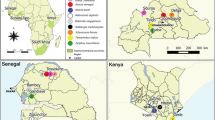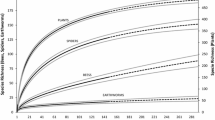Abstract
The stubble-field weed community, dominated by Stachys annua, was generally distributed in Hungary until the 1950s on mid-heavy and heavy, base-rich soils. Stachys annua is an excellent nectar-producer, and from the nectar collected in its habitats popular stubble-honey was produced. This vegetation type has suffered significant decline, mainly due to the early ploughing of stubbles associated with the intensification of agriculture. In the present study, the floristic composition of this community is assessed based on 213 phytosociological records, and its distribution in the past ten years in western Hungary is mapped. Sixty-five percent of the species are of Eurasian, European and Mediterranean elements, and the largest proportion of the species are spring-germinating summer annuals. The proportion of insect-pollinated plant species is approximately 70%, and the species composition also offers significant seed food sources for farmland birds, e.g. Coturnix coturnix and Perdix perdix. Therefore this community should deserve a high conservation priority for biodiversity. The factors that offer the greatest threats to the continuing existence of this community type are intensive agricultural management and the increasing spread of Ambrosia artemisiifolia.
Similar content being viewed by others
References
Albrecht H. & Bachthaler G. 1990. Veränderungen der Segetalflora Mitteleuropas während der letzten vier Jahrzehnte. Verh. Ges. Ökologie 19: 364–372.
Andreasen C., Stryhn H. & Streibig J. 1996. Decline of the flora in Danish arable fields. J. Appl. Ecol. 33: 619–626.
Baessler C. & Klotz S. 2006. Effects of changes in agricultural land-use on landscape structure and arable weed vegetation over the last 50 years. Agr. Ecosyst. Environ. 115: 43–50.
Benedek P. 1997. Structure and density of lucerne pollinating wild bee populations as affected by changing agriculture. Acta Hortic. 437: 353–357.
Bohren C., Mermillod G. & Delabays N. 2006. Common ragweed (Ambrosia artemisiifolia L.) in Switzerland: development of a nationwide concerted action. J. Plant Dis. Protect. Sp. Issue 20: 497–503.
Bonn S. & Poschlod P. 1998. Ausbreitungsbiologie der Pflanzen Mitteleuropas. UTB Grosse Reihe. Quelle und Meyer Verlag, Wiesbaden, 404 pp.
Borhidi A. 2003. Magyarország növénytársulásai. Akadémiai Kiadó, Budapest, 610 pp.
Butler S., Bradbury R. & Whittingham M. 2005. Stubble height affects the use of stubble fields by farmland birds. J. Appl. Ecol. 42: 469–476.
Chamberlain D., Fuller R., Bunce R., Duckworth J. & Shrubb M. 2000. Changes in the abundance of farmland birds in relation to timing of agricultural intensification in England and Wales. J. Appl. Ecol. 37: 77–788.
Dierschke H. 1994. Pflanzensoziologie: Grundlagen und Methoden. Ulmer, Stuttgart, 683 pp.
Eggers T. 1984. Wandel der Unkrautvegetation der Äcker. Schweiz. Landw. Fo. 23: 47–61.
Eliáš P. & Baranec T. 2005. Occurrence of some rare weeds on the territory of Slovakia. Thaiszia 15: 35–43.
Elsen T., Berg M., Drenckhahn D., Dunkel F., Eggers T., Garve E., Kaiser B., Marquart H., Pilotek D., Rodi D. & Wicke G. 2006. Karlstadter Positionspapier zum Schutz der Ackerwildkräuter. J. Plant Dis. Protect. Sp. Issue 20: 527–533.
Evans A., Vickery J. & Shrubb M. 2004. Importance of overwintered stubble for farmland bird recovery: a reply to Potts. Bird Study 51: 94–96.
Faragó S. 1997. Élőhelyfejlesztés az apróvad-gazdálkodásban. Mezögazda Kiadó, Budapest, 356 pp.
Felföldy L. 1942. Szociológiai vizsgálatok a pannoniai flóraterület gyomvegetációján. Acta Geobot. Hung. 5: 87–138.
Gerbaud E., Dutoit T., Barroit A. & Toussaint B. 2001. Mineral contents of cereal stubble: the case of an agricultural exploitation in South-eastern France (Vaucluse). Anim. Res. 50: 495–505.
Gibson R., Nelson I., Hopkins G., Hamlett B. & Memmot J. 2006. Pollinator webs, plant communities and the conservation of rare plants: arable weeds as a case study. J. Appl. Ecol. 43: 246–257.
Goulson D., Hanley M., Darvill B., Ellis J. & Knight M. 2005. Causes of rarity in bumblebees. Biol. Conserv. 122: 1–8.
Gyulai F. 2001. Archaeobotanika. A kultúrnövények története a Kárpát-medencében a régészeti-növénytani vizsgálatok alapján. Jószöveg Kiadó, Budapest, 221 pp.
Hartyányi B., Nováki G. & Patay Á. 1968. Növényi mag- és termésleletek Magyarországon az újkőkortól a 18. századig. M. Mg. Muz. Közlem. 4: 5–84.
Hilbig W. & Bachthaler G. 1992. Wirtschaftsbedingte Veränderungen der Segetalvegetation in Deutschland im Zeitraum von 1950–1990 (Teile 1 und 2). Angew. Bot. 66: 192–209.
Hofmeister H. & Garve E. 1998. Lebensraum Acker. Blackwell Wissenschafts-Verlag, Berlin, 322 pp.
Hüppe J. & Hofmeister H. 1990. Syntaxonomische Fassung und Übersicht über die Ackerunkrautgesellschaften der Bundesrepublik Deutschland. Ber. Reinh. Tüxen-Ges. 2: 61–81.
Jermy T. & Szelényi G. 1958. Az őszi búza állattársulásai. Áll. Közlem. 46: 229–241.
Kästner A., Jäger E. & Schubert R. 2001. Handbuch der Segetalpflanzen Mitteleuropas. Springer Verlag, Wien, New York, 609 pp.
Kearns C., Inouye W. & Waser N. 1998. Endangered mutualisms: The conservation of plant-pollinator interactions. Ann. Rev. Ecol. Syst. 29: 83–112.
Keve A., Kaszab Z. & Zsák Z. 1953. A fürj gazdasági jelentősége. A Mus. Nat. Hung. 4: 197–209.
Király G. (ed.) 2007. Vörös Lista. A magyarországi edényes flóra veszélyeztetett fajai. Saját kiadás, Sopron, 73 pp.
Király G. & Horváth F. 2000. Magyarország flórájának térképezése: lehetőségek a térképezés hálórendszerének megválasztására. Kitaibelia 5: 357–368.
Király G., Pinke Gy. & Mesterházy A. 2006. Veränderung der Verbreitung und Vergesellschaftung ausgewählter Segetalpflanzen in Westungarn: verschiedene Antworten auf die Umformung der Landwirtschaft. J. Plant Dis. Protect. Sp. Issue 20: 557–566.
Kornás J. 1988. Speirochore Ackerwildkräuter: von ökologischer Spezialisierung zum Aussterben. Flora 180: 83–91.
Kőmives T., Béres I., Reisinger P., Lehoczky é., Berke J., Tamás J., Páldy A., Csornai G., Nádor G., Kardeván P., Mikulás J., Gólya G. & Molnár J. 2006. A parlagfü elleni integrált védekezés új stratégiai programja. M. Gyomkut. Techn. 7: 5–49.
Kropáč Z. 2006. Segetal vegetation in the Czech Republic: synthesis and syntaxonomical revision. Preslia 78: 123–209.
Laaidi M., Laaidi K., Besancenot J. & Thibaudon M. 2003. Ragweed in France: an invasive plant and its allergenic pollen. Ann. Allerg. Asthma Im. 91: 195–201.
Lososová Z. 2003. Estimating past distribution of vanishing weed vegetation in South Moravia. Preslia 75: 71–79.
Lososová Z. 2004. Weed vegetation in southern Moravia (Czech Republic): a formalized phytosociological classification. Preslia 76: 65–85.
Marosi S. & Somogyi S. 1990. Magyarország kistájainak katasztere I-II. MTA Földrajz Kut Int, Budapest, 1490 pp.
Marshall E., Brown V., Boatman N., Lutman P., Squire G. & Ward L. 2003. The role of weeds in supporting biological diversity within crop fields. Weed. Res. 43: 77–89.
Mochnacký S. 2000. Syntaxonomy of segetal communities of Slovakia. Thaiszia 9: 149–204.
Mucina L. 1993. Stellarietea mediae, pp.110–168. In: Mucina L., Grabherr G. & Elmmauer T. (eds), Pflanzengesellschaften Österreichs. Teil I. Anthropogene Vegetation. Gustav Fischer Verlag, Jena.
Niklfeld H. 1971. Bericht über die Kartierung der Flora Mitteleuropas. Taxon 20: 545–571.
Nyárády A. 1958. A méhlegelő és növényei. Mezőgazd. Erd. Áll. Könyvkiadó, Bukarest, 434 pp.
Orlowski G. 2006. Cropland use by birds wintering in arable landscape in south-western Poland. Agr. Ecosyst. Environ. 116: 273–279.
Orlowski G. & Czarnecka J. 2007. Winter diet of reed bunting Emberiza schoeniclus in fallow and stubble fields. Agr. Ecosyst. Environ. 118: 244–248.
Petanidou T. & Lamborn E. 2005. A land of flowers and bees: studying pollination ecology in Mediterranean communities. Plant Biosyst. 139: 279–294.
Peternel R., Culig J., Hrga I. & Hercog P. 2006. Airborne ragweed (Ambrosia artemisiifolia L.) pollen concentrations in Croatia, 2002–2004. Aerobiologia 22: 161–168.
Pinke G. 2000. Ackerwildkraut-Gesellschaften extensiv bewirtschafteter Felder in der Kleinen Ungarischen Tiefebene. Tuexenia 20: 335–364.
Pinke G. 2004. Letzte Vorkommen von Caucalion-Arten im Nordwesten Ungarns. Z. Pflanzenk. Pflanzen. Sh. 19: 73–82.
Pinke G. 2007. Ackerwildkraut-Gesellschaften extensiv bewirtschafteter Felder im Transdanubischen Mittelgebirge und dem Westungarischen Randgebiet. Tuexenia 27: 143–166.
Pinke G. & Pál R. 2005. Gyomnövényeink eredete, termőhelye és védelme. Alexandra Kiadó, Pécs, 231 pp.
Pinke G. & Pál R. 2006. Somogy szántóföldi gyomvegetációja. Nat. Somogy 8: 63–78.
Pinke G. & Pál R. 2008. Phytosociological and conservational study of the arable weed communities in western Hungary. Plant Biosyst. 142: (in press).
Pinke G., Pál R., Király G. & Mesterházy A. 2008. Conservational importance of the arable weed vegetation on extensively managed fields in western Hungary. J. Plant Dis. Protect. Sp. Issue 21: 447–452.
Pyšek P., Jarošik V., Kropáč Z., Chytry M., Wild J. & Tichy L. 2005. Effects of abiotic factors on species richness and cover in Central European weed communities. Agr. Ecosyst. Environ. 109: 1–8.
Robinson R. & Sutherland W. 2002. Post-war changes in arable farming and biodiversity in Great Britain. J. App. Ecol. 39: 157–176.
Schneider C., Sukopp U. & Sukopp H. 1994. Biologisch-ökologische Grundlagen des Schutzes gefährdeter Segetalpflanzen. Schr. Vegetationskunde, Bonn-Bad Godersberg, 356 pp.
Slavnić Z. 1951. Pregled nitrofilne vegetacije Vojvodine. N. Zborn. Mat. Novi Sad 1: 84–169.
Šilc U. 2005. Die Unkrautvegetation im Bereich Südost-Slowenien. Tuexenia 25: 235–250.
Šilc U. & Čarni A. 2005. Changes in weed vegetation on extensively managed fields of central Slovenia between 1939 and 2002. Biologia 60: 409–416.
Šilc U. & Čarni A. 2007. Formalized classification of the weed vegetation of arable land in Slovenia. Preslia 79: 283–302.
Simon T. 2000. A magyarországi edényes flóra határozója. Nemzeti Tankönyvkiadó, Budapest, 976 pp.
Soó R. 1964–1980. A magyar flóra és vegetáció rendszertani és növényföldrajzi kézikönyve I–VI. — Akadémiai Kiadó, Budapest, 589, 655, 501, 614, 723 and 557 pp.
Sutcliffe O. & Kay Q. 2000. Changes in the arable flora of central southern England since the 1960s. Biol. Conserv. 93: 1–8.
Tamás J., Reisinger P., Burai P. & David I. 2006. Geostatistical analysis of spatial heterogenity of Ambrosia artemisiifolia on Hungarian acid sandy soil. J. Plant Dis. Protect. Sp. Issue 20: 227–232.
Ubrizsy G. 1954. Vizsgálatok őszi búzavetés agrofitocönózisában. Növénytermelés 3: 281–299.
Ujvárosi M. 1973. Gyomnövények. Mezőgazdasági Kiadó, Budapest, 288 pp.
Ujvárosi M. & Halász T. 1952. A tarlóhántás és a méhészet. Deb. Mg. Int. Évk. 1: 141–146.
Vitalos M. & Karrer G. 2008. Distribution of Ambrosia artemisiifolia L. — is birdseed a relevant vector? J. Plant Dis. Protect. Sp. Issue 21: 345–348.
Wilson P. 1992. Britain’s arable weeds. Brit. Wildlife 3: 149–161.
Wilson J., Morris A., Arroyo B., Clark S. & Bradbury R. 1999. A review of the abundance and diversity of invertebrate and plant foods of granivorous birds in northern Europe in relation to agricultural change. Agr. Ecosyst. Environ. 75: 13–30.
Author information
Authors and Affiliations
Corresponding author
Rights and permissions
About this article
Cite this article
Pinke, G., Pál, R. Floristic composition and conservation value of the stubble-field weed community, dominated by Stachys annua in western Hungary. Biologia 64, 279–291 (2009). https://doi.org/10.2478/s11756-009-0035-5
Received:
Accepted:
Published:
Issue Date:
DOI: https://doi.org/10.2478/s11756-009-0035-5




